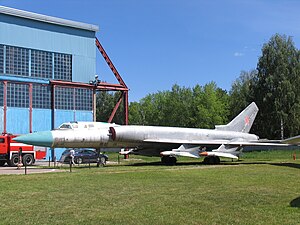Tupolev Design Bureau Tupolev Tu-28 Fiddler
 |
|
| Tu-128 at the Central Air Force Museum at Monino, Russia | |
| Role | Interceptor |
|---|---|
| Manufacturer | Voronezh Aircraft Production Association |
| Design group | Tupolev |
| First flight | 18 March 1961 |
| Introduction | 1964[1] (or 1966[2]) |
| Retired | 1990 |
| Primary user | Soviet Air Defence Forces |
| Number built | 198[1] (including 10 trainers) |
| Developed from | Tupolev Tu-98 |
|
|
.
History Public Joint Stock Company Tupolev,
Tupolev Tu-28 (NATO reporting name Fiddler

The Tupolev Tu-28 (NATO reporting name Fiddler) was a long-range interceptor aircraft introduced by the Soviet Union in the 1960s. The official designation was Tu-128, but this designation was less commonly used in the West. It was the largest and heaviest fighter ever in service.
Design and Development

Iosif Nezval of Tupolev Design Bureau led development of the new interceptor aircraft. The work began in 1958, based on an existing single prototype of the unsuccessful Tu-98 supersonic bomber. The military designation of the interceptor was at first Tu-28, but it was changed in 1963 to Tu-128, identical to the designation used by the OKB.
The Tu-128 had a broad, low/mid-mounted swept wing carrying the main landing gear in wing-mounted pods, and slab tailplanes. Two Lyulka AL-7F-2 turbojet engines were mounted in the fuselage. The two-man crew of pilot and navigator were seated in tandem.
The Tu-128, with its maximum weight of 43 tonnes, was the heaviest fighter to enter service. A pure interceptor with high wing loading, unsophisticated but reliable avionics, and poor visibility, it was not an agile aircraft and was intended only to engage NATO bombers like the B-52, not dogfight smaller aircraft.
0
KmCeiling
0
KmCombat RANGE
0
MachAircraft Speed
0
Max Crew
Photo Gallery
Public Joint Stock Company Tupolev,
Tupolev Tu-28 (NATO reporting name Fiddler


Public Joint Stock Company Tupolev,
Tupolev Tu-28 (NATO reporting name Fiddler
General Info
-
-
-
-
- Crew: 2
- Length: 30.06 m (98 ft 7 in)
- Wingspan: 17.53 m (57 ft 6 in)
- Height: 7.15 m (23 ft 5 in)
- Wing area: 96.94 m2 (1,043.5 sq ft)
[
-
-
-
Powerplant
-
-
-
-
- Empty weight: 24,500 kg
- Gross weight: 40,000 kg
- Max takeoff weight: 43,000–43,700 kg (94,799–96,342 lb)
- Fuel capacity: 13,600 kg (29,983 lb) maximum (estimated)
- Powerplant: 2 × Lyulka AL-7F-2 afterburning turbojet engines, 72.8 kN (16,400 lbf) thrust each dry, 99.1 kN (22,300 lbf) with afterburner
-
-
-
Performance
-
- Maximum speed: 1,665 km/h (1,035 mph, 899 kn) / M1.5 armed
-
-
-
- 1,929 km/h (1,199 mph; 1,042 kn) un-armed
-
-
- Range: 1,560 km (970 mi, 840 nmi)
- Endurance: >3 hours
- Service ceiling: 15,600 m
- Absolute ceiling: 20,000 m
- g limits: +2.5
Armament
-
- Hardpoints: 4
- Missiles: 4 × Bisnovat R-4 air-to-air missiles (usually 2 × radar-guided R-4R and 2 × infrared-homing R-4T); other armament or tanks not used
.
Links to Youtube & Others
Between 1970 and December 2016 there were 110 serious incidents involving the Tu-154, including 73 hull losses,
with 2,911 fatalities.
Tupolev Design Bureau Tupolev Tu-28 Fiddler
In October 2020 ALROSA, the last Russian passenger airline to operate this aircraft, retired its last remaining Tu-154
Youtube Link
In January 2010 Russian flag carrier Aeroflot announced the retirement of its Tu-154 fleet after 40 years, with the last scheduled flight being Aeroflot Flight 736 from Yekaterinburg to Moscow on 31 December 2009.












